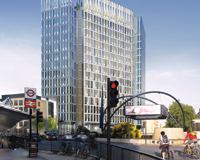When David Cameron launched the East London Tech City initiative just over a year ago, he told the world’s media not to “doubt our ambition”. He wants to transform a stretch of east London, from Shoreditch to the Olympic Park in Stratford, into “one of the world’s great technology centres”.
Few doubt the project is ambitious. But with another recession lurking, a dotcom bubble still in living memory and a relatively immature market in east London, will fibre-optic cables ever realise the pipe dream?
Tech City is being driven by UK Trade & Investment, part of the Department of Trade and Industry. It includes the eastern extremity of the borough of Islington and parts of Hackney, Tower Hamlets and Newham.
Its epicentre is Old Street roundabout in EC1, dubbed “Silicon Roundabout”.
Shaun Simons, director of the City’s Hatton Real Estate, says: “The process has already started. We deal with a number of buildings around Old Street and nine times out of 10 we are letting to tech companies.”
As testament to the area’s growing reputation, several agents report that buildings that would normally be let only in a very strong market are finding tenants. Five years ago, companies took space around Old Street only if they could not get into neighbouring Clerkenwell.
In 2007, technology magazine Wired reported there were only 15 technology start-ups near Silicon Roundabout. Now there are more than 100. The Tech City Investment Organisation estimates there are more than 300 companies across the whole zone.
One of the most significant, if not the most significant, of these is the recent letting by internet giant Google. In September, it took a 10-year lease on a seven-storey building at 4-5 Bonhill Street, EC2, just 500 yards from Silicon Roundabout.
Google has been at pains to stress that this is not related to its 700,000 sq ft UK headquarters requirement. The lease, from the Corporation of London, is for an innovation and incubation hub. Google hopes to open the centre next year.
“This is only going to drive confidence and traffic to the area,” says Chris Antoniou, partner at Clerkenwell agent Anton Page.
Pushing eastwards
Google is rumoured to favour King’s Cross for its HQ requirement. Although technically outside Tech City’s boundaries, it is relatively close and such a move would certainly push high-tech activity eastwards.
Data-hosting company Telecity already has a data centre 100 yards from Silicon Roundabout, in Oliver’s Yard, and is rumoured to be looking for another centre in the area because of the exceptionally good connectivity.
Chris Williams-Ellis, senior director in BNP Paribas Real Estate’s City office, says: “The technology, media and telecommunications sector is one of the most active in the market. Banks and law firms are not doing anything at the moment, so from a purely money-making perspective, it seems sensible to try to tap into it.”
Of course, cynics might say that with so much money being pumped into the 2012 Olympics, the government has to ensure a return on its investment somewhere. Nevertheless, it has pledged £200m of equity finance through Enterprise Capital Funds for high-growth businesses.
Antoniou adds: “Whether you are a fan of Cameron or not, his speech has made a difference. Ever since then, there have been regular stories in the press and the more hype there is, the more likely it is to happen. It will give confidence to landlords.”
REIT Derwent London has planning permission for a 290,000 sq ft redevelopment of five redundant 1950s and 1960s office buildings, including 271,000 sq ft of offices on the south-west corner of Silicon Roundabout.
It is proposing a 16-storey, mainly office, tower – a BREAAM excellent “white-collar factory” that “turns its back on the grandiose buildings of the era of excess”, according to Derwent’s head of regeneration, Simon Silver.
The £105m capital expenditure scheme sits on a 1-acre site, around a public square at the City Road Estate and includes 271,000 sq ft of offices, 10,000 sq ft of retail and 8,000 sq ft of residential accommodation.
“We do think it much more likely to be attractive to creative or technology companies, rather than finance companies from the City,” he adds. “It will attract people from Midtown and the West End. But will it still be called Silicon Roundabout when our building goes up? I don’t know.”
However, it is not scheduled to be developed before mid-2014 at the very earliest and, as it stands, Derwent will seek a prelet.
Chris Hiatt, chairman of Jones Lang LaSalle’s national office agency, says: “If you want to have a clean sheet, do something creative and deliver it in a short space of time, you cannot look to the City or West End. But further east you have more space and cleared sites. Where do you go after King’s Cross?”
Twitter causes a flutter
A question trending among Tech City supporters is why online social network Twitter announced in September – appropriately enough, via a Tweet – that it was locating its international operations in Dublin, rather than London.
Competition between the two capitals to fulfil the requirement had been intense. David Cameron and London mayor Boris Johnson met Twitter executives last year in a bid to secure it as an anchor tenant for Tech City. So, when Twitter announced earlier this year that jobs were to be created in Tech City, it looked like a done deal.
But the job creation involved a defensive £25m takeover of Clerkenwell-based TweetDeck, an information network that pools social media into a single interface. Twitter was concerned about a rival bid from UberMedia and not so concerned about a UK headquarters.
The most likely explanation is Ireland’s 12.5% corporation tax rate. It is possible for UK sales to be channelled via the Dublin HQ, more than halving the rate paid.











